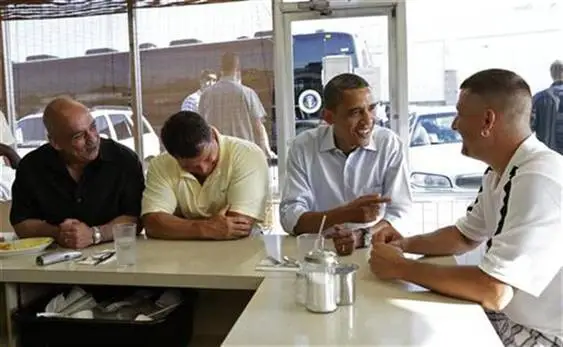No Wonder President Obama Is Having Trouble Formulating an Economic Growth Message

With Little to Say, Obama Eats Grits in Rust Belt

With Right to Work a taboo subject, President Obama is finding it difficult to explain how the national economy can begin growing healthily again. Photo: Reuters/Kevin Lamarque
Last week, President Obama’s re-election campaign sent him on a two-day bus tour of northern Ohio and western Pennsylvania, historically Democratic Rust Belt territory.
Syndicated columnist Michael Barone (see the link above) has wondered aloud why the Obama team clearly feels the need to shore up his poll numbers in a region of the country the President carried by a 56-42 margin in 2008. Barone concludes, not surprisingly, that the disappointment felt by many of Obama’s erstwhile supporters about the economy is a major problem for his 2012 campaign. By any reasonable standard, the national economy has failed to recover adequately from the recession that officially ended three years ago.
Moreover, because of the array of special interest groups upon whom President Obama is continuing to rely for support this year, his policy options for getting job and income growth back on track are tightly constrained. The case of Big Labor is the most compelling example of all.
New and revised data released by the U.S. Commerce Department in June show yet again that federal policies authorizing the termination of employees for refusal to pay dues or fees to a union, whether they want it or not, are an albatross on job-creating businesses. From 2001 to 2011, the 22 states that at that time had exercised their prerogative to put Right to Work laws on the books protecting employees from federally-imposed forced unionism experienced combined real GDP growth of 20.6%. Right to Work states’ real GDP gain was 5.3 percentage points greater than that of the nation as a whole, and a full 8.3 percentage points greater than the average for the 28 forced-unionism states. (Just this February,Indiana banned compulsory union dues and fees. It became the 23rd Right to Work state when this law took effect the following month.)
The Commerce Department data show that Right to Work states have an advantage in good times and bad times alike. They grew far more rapidly than forced-union-dues states from 2001 to 2007, when the national economy was performing relatively well. And from 2007 to 2011, while the aggregate real GDP of forced-unionism states shrank, Right to Work states enjoyed a modest gain. Within each U.S. Census Bureau region that contains both types of states – the West, the Midwest, and the South – Right to Work states enjoyed superior growth from 2001 to 2011. In the Midwest alone, Right to Work states grew by nearly five times as much as did forced-unionism states.
Rigorous analyses such as a recent study coauthored by Oregon economists Eric Fruits and Randall Pozdena point to a causal link between Right to Work laws and economic growth, but the President plainly believes he must oppose all such measures, at both the state and federal levels, in order to placate the union officials who are heavily bankrolling his re-election efforts. That’s one important reason why Obama “doesn’t have a convincing economic story to tell,†as Barone concludes.

